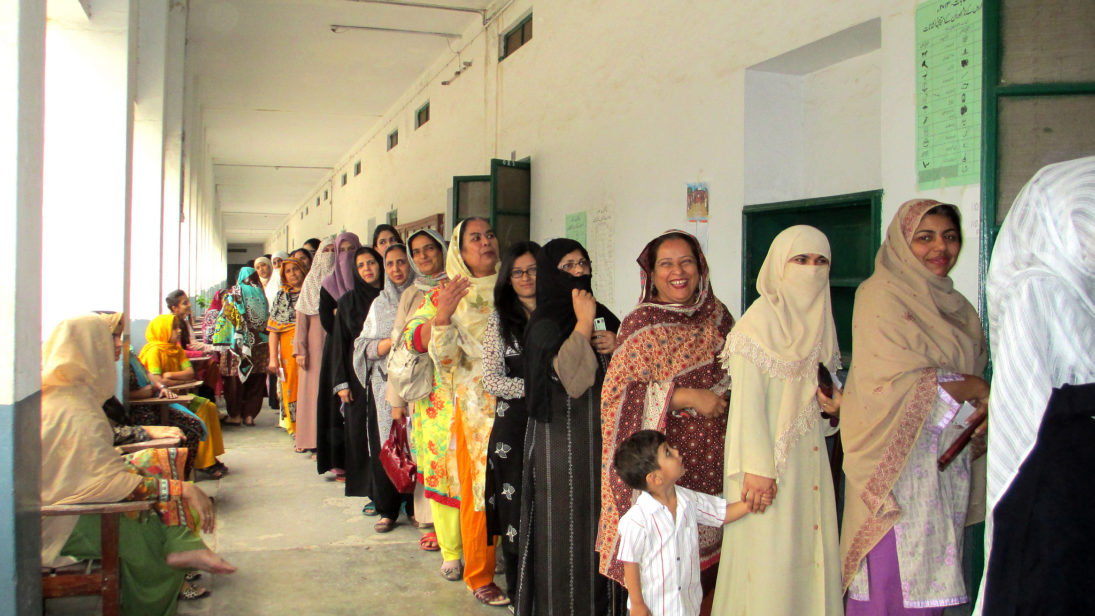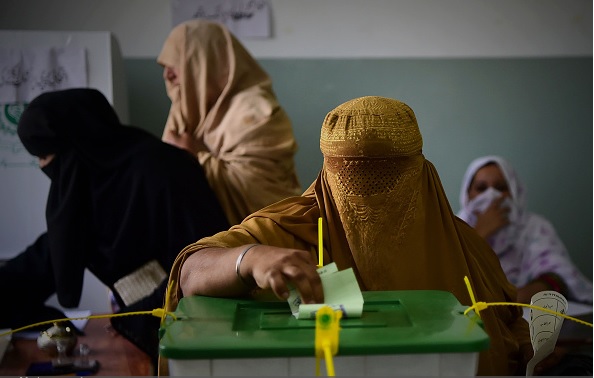
The run-up to Pakistan’s 2018 general elections witnessed an increased focus on women’s political participation with higher female voter turnout in much of the country. In particular, the Elections Act of 2017 recognized the need to increase representation of women in politics (as voters and candidates) and imposed three key measures to promote their participation. First, the Act mandated that returns from any constituency where women’s turnout was less than or equal to 10 percent be nullified. Second, it criminalized the practice of preventing a woman from voting in or contesting an election. Third, it required all political parties to list female candidates in at least five percent of their non-reserved national and provincial assembly seats. The Electoral Commission of Pakistan (ECP) also promoted women-only polling stations with female staff to encourage voter turnout in more conservative parts of the country.
The minimum requirement for women as voters and candidates has led to greater participation and visibility of women in the recent elections. However, the increased numbers do not signify lasting gains for gender-equality and women’s roles in Pakistani politics. These changing trends have not affected the patriarchal and male-dominated political structure, preventing the mainstreaming and equal participation of female candidates and voters who remain a minority. Women still face informal restrictions on voting in parts of the country, with females perceived as less capable politicians who face threats of violence.
Upward Trend of Female Participation
In the 2018 elections, the registration of female voters in Pakistan’s northwestern tribal areas (the erstwhile Federally Administered Tribal Areas, now part of Khyber Pakhtunkhwa province) increased by 66 percent over the previous 2013 election. Women now represent 44 percent of registered voters nationwide, a slight improvement from 43.6 percent in the 2013 elections. Despite an overall decrease in voter turnout, female voter turnout in 2018 is estimated at 23.26 million, an increase compared to 22.9 million in the 2013 general elections. Constituencies with the highest percentage of female voter turnout included Tharparkar in Sindh province and Bhakkar, Attock, and Bahawalpur in Punjab province.
Women also made history in parts of Khyber Pakhtunkhwa and the Dir, Kohistan and North and South Waziristan constituencies, where anecdotal reports indicate that many exercised their right to vote for the first time. Even though Pakistan’s Constitution granted women the right to vote in 1956 and residents of former FATA agencies gained voting rights in 1996, certain local tribes and tribunals dominated by men had prevented women from voting.
Limited Gains for Women
Despite these positive developments, the tribal areas remained the constituencies with the lowest percentages of overall female voter turnout. Access issues emerged in Khyber Pakhtunkhwa province, where a group of men barred women from voting in Swabi district, forcing authorities to intervene. A female polling station in Peshawar was also attacked by a group of men attempting to shut it down. Although more women ran for office in 2018 compared to previous elections, the overall percentage remained abysmal, with women representing just 2.6 percent of all candidates.
Women’s participation in the electoral process continues to face a significant gender gap. Of the country’s nearly 106 million registered voters, 59.2 million are male and 46.7 million are female. Despite some recent gains in female participation, Pakistan ranks last in the world for female turnout in elections, with nearly 20 percent fewer women than men having voted in the previous national election, according to survey data.
The ECP’s efforts to encourage women in politics have been only partially successful. After the ECP ruled that five percent of each party’s candidates for general (non-reserved) seats should be women, several parties put forward female candidates. Allah-o-Akbar Tehreek, with links to the banned organization Jamaat-ut-Dawa, promoted 10 female candidates despite speaking against female participation in the workforce. Such gains were limited as several parties reportedly placed female candidates in “weak” seats they were bound to lose against influential candidates. Moreover, 59 political parties refused to allot the minimum number of seats to women and were still allowed to contest the elections.
Overall, the lack of real change in women’s representation is linked to archaic opinions that a woman’s place is in the home, while politics is the domain of men. A 2012 report by the Aurat Foundation, a Pakistani women’s rights organization, found that Pakistan’s male-dominated political structure is detrimental to women’s political participation as voters and candidates. Some factors that limit or completely prevent women’s presence in politics include socio-cultural resistance, patriarchal restrictions, and religious limitations or extremism.

Biases and Violence Against Women in Politics
While there are examples of influential and successful female politicians, they have been targeted and defamed in the country’s history. A majority of women remain out of politics, and the minority that actively participates is often belittled and delegitimized based on their gender. For instance, Fatima Jinnah, sister of the founder of Pakistan, Muhammad Ali Jinnah, faced stark opposition from military dictator Ayub Khan’s lobby against becoming the President of the country.
After Benazir Bhutto was elected Prime Minister, a series of fatwas (religious edicts) were issued by leading Islamic clerics stating that a woman could not be the head of an Islamic country. Her political opponents circulated doctored pictures of her in a swimsuit to discredit Bhutto as a Westernized woman who would morally degrade the country. In a more extreme case, Zille Huma Usman, Punjab’s Minister for Social Welfare, was killed in 2007 simply for being a female politician. Authorities reported that the attacker targeted her because she was not wearing “Muslim” clothing and due to his belief that Islam does not allow women to be “rulers.” This time around, five female candidates received threats of physical harassment from rival party members, urging them to withdraw from the elections.
A 2014 report on “Violence against Women in Politics” in India, Nepal and Pakistan revealed that female politicians face continued isolation, physical violence, and harassment. They are also perceived as less likely to win seats and are not given tickets to contest elections. According to the same report, such incidents stem from a patriarchal mindset where many lack confidence in women’s educational and political capabilities. In particular, 53 percent of Pakistanis surveyed believed that women do not have the required political skills, necessitating that their husbands and fathers assume their positions.
Increasing Women’s Participation
Women represent more than 48 percent of Pakistan’s population and yet remain a minority in political processes due to institutionalized patriarchy and gender biases. However, exceptions to the norm do exist, and female politicians have held central positions in the past, with Benazir Bhutto as the first female Prime Minister and Hina Rabbani Khar as the youngest and first female Foreign Minister. To move closer to institutionalized equality, quotas on women’s participation need to be paired with sustainable educational programs to further empowerment. Otherwise, women will continue to hold ceremonial positions with weak decision-making abilities. When women are a minority in politics, it is also less likely that majority male lawmakers will focus on legislation regarding economic security, gender-based violence, and social mobility for women.
Overall, the ECP’s gender-specific policies must go together with initiatives to develop a political culture that encourages the participation of women. The government should also urge mainstream political parties to make women’s involvement a key aspect of campaigns. As political parties have reportedly avoided fielding female candidates to prevent upsetting religious clergy and extremists, there is a need to promote moderate religious messages negating misconceptions about women’s participation in politics.
***
Image 1: DFID via Flickr
Image 2: Abdul Majeed/AFP via Getty Images


